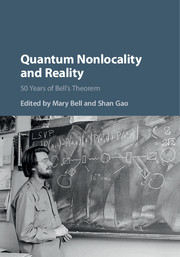Book contents
- Frontmatter
- Contents
- Contributors
- Preface
- Preface
- Part I John Stewart Bell: The Physicist
- Part II Bell's Theorem
- Part III Nonlocality: Illusion or Reality?
- Part IV Nonlocal Realistic Theories
- 19 Local Beables and the Foundations of Physics
- 20 John Bell's Varying Interpretations of Quantum Mechanics: Memories and Comments
- 21 Some Personal Reflections on Quantum Nonlocality and the Contributions of John Bell
- 22 Bell on Bohm
- 23 Interactions and Inequality
- 24 Gravitation and the Noise Needed in Objective Reduction Models
- 25 Towards an Objective Physics of Bell Nonlocality: Palatial Twistor Theory
- 26 Measurement and Macroscopicity: Overcoming Conceptual Imprecision in Quantum Measurement Theory
- Index
- References
24 - Gravitation and the Noise Needed in Objective Reduction Models
from Part IV - Nonlocal Realistic Theories
Published online by Cambridge University Press: 05 September 2016
- Frontmatter
- Contents
- Contributors
- Preface
- Preface
- Part I John Stewart Bell: The Physicist
- Part II Bell's Theorem
- Part III Nonlocality: Illusion or Reality?
- Part IV Nonlocal Realistic Theories
- 19 Local Beables and the Foundations of Physics
- 20 John Bell's Varying Interpretations of Quantum Mechanics: Memories and Comments
- 21 Some Personal Reflections on Quantum Nonlocality and the Contributions of John Bell
- 22 Bell on Bohm
- 23 Interactions and Inequality
- 24 Gravitation and the Noise Needed in Objective Reduction Models
- 25 Towards an Objective Physics of Bell Nonlocality: Palatial Twistor Theory
- 26 Measurement and Macroscopicity: Overcoming Conceptual Imprecision in Quantum Measurement Theory
- Index
- References
Summary
Abstract
I briefly recall intersections of my research interests with those of John Bell. I then argue that the noise needed in theories of objective state vector reduction most likely comes from a fluctuating complex part in the classical spacetime metric; that is, state vector reduction is driven by complex-number-valued “space–time foam.”
Introduction
My research interests have intersected those of John Bell three times. The first was when I found the forward lepton theorem for high-energy neutrino reactions, showing that for forward lepton kinematics, a conserved vector current (CVC) and a partially conserved axial vector current (PCAC) imply that the neutrino cross section can be related to a pion scattering cross section [1]. This led to an exchange of letters and discussions with Bell during 1964–5, which are described in the Commentaries for my selected papers [2]. The second was in the course of my work on the axial-vector anomaly [3], when I had further correspondence with John Bell, as described both in the Commentaries [4] and in the volume of essays on Yang–Mills theories assembled by 't Hooft [5]. The third time was a few years after Bell's death in 1990, when I became interested in the foundations of quantum theory and the quantum measurement problem, in the course of writing my book on quaternionic quantum mechanics [6]. Foundational issues in standard, complex quantum theory had preoccupied Bell for much of his career and led to his best known work. However, my correspondence with Bell in the 1960s never touched on quantum foundations, and I only read his seminal writings on the subject much later on. In this article I focus on this third area of shared interests.
Objective Reduction Models
There is now a well-defined phenomenology of state vector reduction, pioneered by the work of Ghirardi, Rimini, andWeber (GRW) and of Philip Pearle, and worked on by many others. John Bell was interested in this program from the outset.
Information
- Type
- Chapter
- Information
- Quantum Nonlocality and Reality50 Years of Bell's Theorem, pp. 390 - 399Publisher: Cambridge University PressPrint publication year: 2016
References
Accessibility standard: Unknown
- 7
- Cited by
